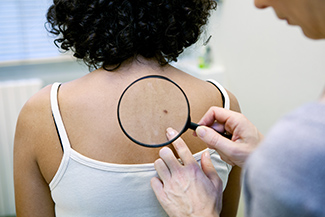Types of Skin Cancer
Melanoma is typically the first type of skin cancer that comes to mind, but it actually is not the most common skin cancer.
Basal Cell Carcinoma and Squamous Cell Carcinoma are, in fact, the two most common types. These and other nonmelanomic skin cancers kill more than 5,000 people every month, but are very treatable if spotted early and diagnosed by a physician.
Basal Cell Carcinoma (BCC)
Your top layer of skin is made up of three primarily cell types, one of which is basal cells. When these cells are damaged at the DNA level, typically by UV light radiation which prompts uncontrolled growth, these cells can evolve into Basal Cell Carcinoma. This is the most common form of skin cancer with upwards of 3.6 million cases diagnosed annually in the United States.
If untreated, BCC can become locally invasive and expanding in size and depth – potentially even into bone. Fortunately BCC rarely metastasizes throughout the body, and with early detection, nearly all BCCs can be removed successfully.
Some signs of BCC to watch for include:
- An open sore that does not heal and may seem to disappear and reappear. It will probably bleed or ooze.
- A new reddish patch or irritated area that persists
- A shiny bump or nodule For people of color, it may be tan, black or brown, and can be mistaken for a mole. On fair skin, it is usually pearly, pink, red or white.
- A small pink growth that is slightly raised It will have rounded edges and crust in the middle.
- A scar-like area that will make the skin appear shiny and taut and is usually flat, yellow or waxy in color.
Squamous Cell Carcinoma (SCC)
The second most common type of skin cancer, squamous cell carcinoma, also occurs when UV light radiation damages one of the three primary cell types in the top layer of your skin, causing abnormal growth.
Though less common than basal cell carcinoma, it is becoming more common. There has been a 200% increase in recorded cases over the last thirty years.
SCC can appear differently on each person, but some common symptoms to look out for include:
- A persistent scaly red patch with irregular borders It will sometimes crust or bleed.
- An elevated growth with a central depression that may rapidly increase in size and will sometimes bleed.
- An open sore or wart-like growth that bleeds or crusts and persists for weeks
SCC lesions can grow quickly and become disfiguring. If ignored and left untreated, SCCs can spread and become deadly by burrowing deeper into the body. But if found early, the majority can be quickly and successfully treated.
Melanoma
The most dangerous type of skin cancer is Melanoma. Melanoma occurs when the pigment-producing cells that give color to the skin become cancerous and can occur anywhere on the body.
You can recognize the warning signs by learning your ABCDE’s:
- Asymmetry: Common moles are symmetrical, melanoma often is not.
- Border: Melanoma will often have uneven borders and rough edges.
- Color: Look out for moles with multiple colors, particularly shades of brown, black and tan.
- Diameter: Any mole the size of a pencil eraser or bigger is suspect.
- Evolving: Benign moles are pretty unchanging. Any change in size, shape or color should be investigated.
Treatment for Melanoma may involve medication, surgery, radiation or chemotherapy.
Risk Factors
There are many common risk factors for developing skin cancer, such as having fair skin or having prolonged exposure to UV radiation from the sun or tanning beds. Being over 50 or male also increases your risk. But skin cancer is very treatable when caught early.
We recommend being observant and proactive with your skin:
- Examine your entire body every month Skin cancer can even develop even in places with very little sun exposure. For people of color, it is important to check under fingernails and toenails, as well as palms and soles of the feet.
- See your dermatologist annually Be proactive and get a professional skin exam every year.
- Find something suspicious? Trust your gut and get a professional opinion.
- Protect your skin every day Practice sun safety daily by using sunscreen, wearing protective hats and clothing, and staying in the shade. Also avoid tanning beds.
More questions? Our dermatology team can help!
Or contact the Brian D. Jellison Cancer Institute at 941-917-1981 to learn about upcoming cancer screenings, education events, the latest cancer care research and other services and resources


